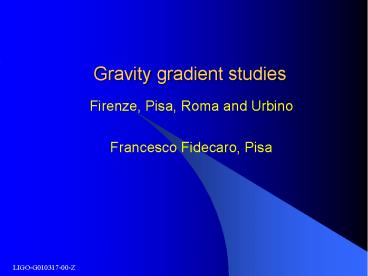Gravity gradient studies PowerPoint PPT Presentation
Title: Gravity gradient studies
1
Gravity gradient studies
- Firenze, Pisa, Roma and Urbino
- Francesco Fidecaro, Pisa
2
Physics near the low frequency limit
- Inspiral when massive objects are involved
- Signal goes like
- 1/R, M 5/6, f--7/6
- There is a maximum frequency
- Ringdown (Rasio 700 Hz)
- Last stable orbit (Grishchuk, Lipunov, Postnov,
Prokhorov and Sathyaprakash, astro-ph0008481) - Red shift (not considered here)
- GW from known pulsar
3
Detectors capability
4
Integrated SNR NSNS
5
100100 M? 100 Mpc
6
(No Transcript)
7
Slowdown from pulsar
- Upper limits on amplitudes from known pulsars,
set by assuming spindown due to the emission of
gw energy. The points represent all pulsars with
gravitational wave frequencies above 7 Hz and
amplitudes above 10-27. - Expected sensitivities of three first-generation
interferometers in a one-year observation, and
the thermal noise limits on narrow-banding
(dotted lines). K.A.Compton and B.F.Schutz,
Cascina, 1996
8
Local gravity fluctuations
- Cant be separated from true GW signal
- Related to local mass movement or density
fluctuations - Stick out of the seismic wall
- Work by Weiss, Saulson, Hughes and Thorne, Cella
9
Seism induced gravity fluctuations
- Seismic waves crossing interferometer corner and
end points - Horizontal shear waves have no effect
- Longitudinal waves have density variation
- Rayleigh waves give the main contribution,
combination of horizontalvertical motion at free
boundary. - These are surface waves, with specific
propagation characteristics
10
Study of gravity fluctuation
- Suggested by Thorne ground geophysical
information, layer position and composition - Wave speed
- Local diffusion
- To construct a model that predicts the
composition of a seismic wave (frequency, modes,
direction) using a finite set of measurements
11
A dedicated study
- Groups from Pisa, Firenze, Urbino, Roma
- Original Proposal by
- G. Calamai, E. Cuoco, P. Dominici, M. Mazzoni, M.
Ripepe, R. Stanga, G. Losurdo, A. Bertolini, N.
Beverini, F. Caratori, C. Carmisciano, G. Cella,
O. Faggioni, I. Ferrante, F. Fidecaro, F.
Strumia, R. Tripiccione, A. Viceré, E. Majorana,
P. Puppo, P. Rapagnani, G.M. Guidi, F. Martelli,
F. Vetrano - Funded independently of Virgo
- Geophysical data collection and measurements
- Analytical and numerical model
- Development of cheap vertical accelerometers
12
Goals
- Establish the geology and the geophysics of site
- Establish analytic and numeric model for wave
propagation, compute effects on test mass - Simulate response of an array of accelerometers
- Develop code to test methods for gravity gradient
subtraction - Prototype vertical accelerometer
- Prototype field data acquisition system
13
Geophysics
- Geophysical model in traditional way
- Three homogenous plane parallel layers
- One cilindrical layer on top (Arno river
sediments) - Mathematical model in progress
- Boundary conditions between layers
- Eigenmodes classification
- Dispersion relations
- Comparison with FEM numerical approach
- Comparison with LIGO sites would be useful,
already benefited from discussions with Sz.
Márka, would like to make plans for joint efforts
14
Seismic gravity gradient geology
- Geological layer model of Cascina site being
completed - Based on available maps, sampling and seismology
- Differential gravity measurements
- To obtain a profile of the depth of the effective
boundary between the first two layers. - About 150 (/- 30) measurements needed
Dg/Dh
H2
g1
H1
g2
15
Thorne Hughes paper
16
ANSYS Simulation
17
Seismic gravity gradient correction
- Based on ground motion measurement around mirrors
- Establish expected correlation between motion and
local gravity field - Linear system take projection of seismic modes
on accelerometer array - Invert accelerometer array readout to obtain
expected local gravity field
18
Noise subtraction (Cella)
19
Vertical accelerometer
- Development of a dedicated vertical accelerometer
- Based on GAS concept
- Capacitive readout
- To be produced in hundreds
- Ease of assembly
- Reproducible
- Stable
20
Atmospheric gravity gradient (not yet proposed)
- Work by R Weiss, P Saulson, T Creighton
- Building induced eddies density variation
- (Creighton)
- Ground induced density variations
- Wind induced turbulence building, trees
- Sound wave 74 dB correspond to 0.1 Pa 10-6 bar
- 10x10x30 m3 mass change of 3 g
- Acceleration at 10 m 2 x 10-15 ms-2
- At 10 Hz dh 1.6 x 10-22 down to 5 x 10-23 with
more appropriate treatment
21
Actual conditions
- Not much is known of relevant parameters and of
their statistical properties - Need measurements, usual knowledge doesnt really
apply - Need to known this on a scale of 100 m
- Meteo conditions
- Pressure and pressure spatial correlation
- T and T spatial correlation
22
Measurement tools
- Temperature correlation on ground
- Infrasound microphone
- Instruments for atmospheric researchSodar
- Also measurements for active optics correction,
scintillation on short distances
23
Perspectives on atmospheric effects
- Will propose to Virgo some long due measurements
on site to assess effect - Infrasound
- Wind
- Temperature
- Then evaluate whether to propose a dedicated
effort

